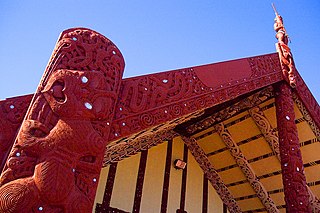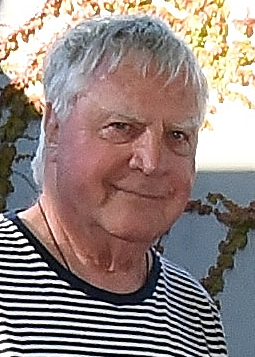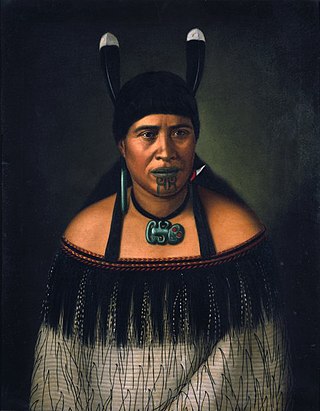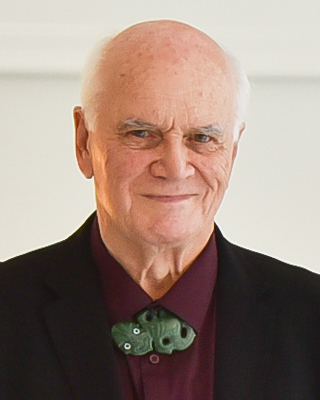
Māori culture is the customs, cultural practices, and beliefs of the indigenous Māori people of New Zealand. It originated from, and is still part of, Eastern Polynesian culture. Māori culture forms a distinctive part of New Zealand culture and, due to a large diaspora and the incorporation of Māori motifs into popular culture, it is found throughout the world. Within Māoridom, and to a lesser extent throughout New Zealand as a whole, the word Māoritanga is often used as an approximate synonym for Māori culture, the Māori-language suffix -tanga being roughly equivalent to the qualitative noun-ending -ness in English. Māoritanga has also been translated as "[a] Māori way of life." The term kaupapa, meaning the guiding beliefs and principles which act as a base or foundation for behaviour, is also widely used to refer to Māori cultural values.

Gordon Frederick Walters was a Wellington-born artist and graphic designer who is significant to New Zealand culture due to his representation of New Zealand in his Modern Abstract artworks.

Auckland Art Gallery Toi o Tāmaki is the principal public gallery in Auckland, New Zealand. It has the most extensive collection of national and international art in New Zealand and frequently hosts travelling international exhibitions.

Sir Mountford Tosswill "Toss" Woollaston was a New Zealand artist. He is regarded as one of the most important New Zealand painters of the 20th century.
Richard John Killeen is a significant New Zealand painter, sculptor and digital artist.

Hamish Henry Cordy Keith is a New Zealand writer, art curator, arts consultant and social commentator.

New Zealand art consists of the visual and plastic arts originating from New Zealand and comes from different traditions: indigenous Māori art and that brought here including from early European mostly British settlers.
Mark Adams is one of New Zealand's most distinguished photographers.
Te Maori was a watershed exhibition of Māori art in 1984. It is notable as the first occasion on which Māori art had been exhibited by Māori, and also the first occasion on which Māori art was shown internationally as art. In retrospect it is seen as a milestone in the Māori Renaissance.
Milan Mrkusich was a New Zealand artist and designer. He was considered a pioneer of abstract painting in New Zealand. Retrospective exhibitions of his work were organised by the Auckland Art Gallery in 1972 and 1985, and at the Gus Fisher Gallery in 2009. A substantial monograph was published by Auckland University Press in 2009.
Ian Christopher Scott was a New Zealand painter. His work was significant for pursuing an international scope and vision within a local context previously dominated by regionalist and national concerns. Over the course of his career he consistently sought to push his work towards new possibilities for painting, in the process moving between abstraction and representation, and using controversial themes and approaches, while maintaining a highly personal and recognisable style. His work spans a wide range of concerns including the New Zealand landscape, popular imagery, appropriation and art historical references. Scott's paintings are distinctive for their intensity of colour and light. His approach to painting is aligned with the modernist tradition, responding to the formal standards set by the American painters Morris Louis, Kenneth Noland and Jules Olitski.

Maureen Robin Lander is a New Zealand weaver, multimedia installation artist and academic. Lander is of Ngāpuhi and Pākehā descent and is a well-respected and significant artist who since 1986 has exhibited, photographed, written and taught Māori art. She continues to produce and exhibit work as well as attend residencies and symposia both nationally and internationally.

Arnold Manaaki Wilson was a New Zealand artist and educator of Māori descent. He is regarded as a pioneer of the modern Māori art movement.
Diane Prince is a painter, weaver, installation art practitioner and set designer and affiliates to the Maori iwi Ngā Puhi and Ngāti Whātua from the north of New Zealand.

Raymond Henry "Sandy" Adsett is a New Zealand visual artist and educator. He is acknowledged for championing the art of kōwhaiwhai painting, creating a context for the artform within the development of contemporary Māori art.

Spiral, also known as Spiral Collective or Spiral Collectives, is a New Zealand publisher and group of artist collectives established in 1975 with a focus on female artists and voices. Members of Spiral have published and created a number of projects and works including, notably, the Spiral journal, A Figurehead: A Face (1982) by Heather McPherson, The House of the Talking Cat (1983) by J.C. Sturm, the bone people (1984) by Keri Hulme, numerous art exhibitions and documentary films.

John Bevan Ford was a New Zealand Māori artist and educator who started exhibiting in 1966. He is a leading figure in contemporary Māori art with art held in all large public collections of New Zealand. In 2005 Ford received the Creative New Zealand Te Waka Toi Kingi Ihaka Award.

Gordon Harold Brown is a New Zealand art historian, curator, and artist.
The Petar/James Gallery was the first New Zealand dealer gallery to focus on abstract art and the idea of Internationalism.
Headlands: Thinking Through New Zealand Art was an exhibition of New Zealand art organised in partnership by the Museum of Contemporary Art (MCA), Sydney and the National Art Gallery, Wellington, in 1992











